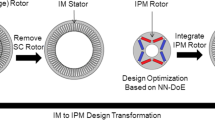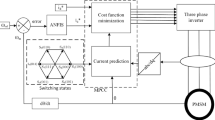Abstract
Electric vehicles are a key technology to decarbonize the transport sector where interior permanent magnet synchronous motors (IPMSMs) are the best performer at the heart of the electrical drive system. In order to optimize their operational efficiency, the model-based method associated with parameter identification is widely adopted. However, efficiency optimization and parameter identification in the existing methods are implemented independently by different strategies in a sequential execution manner, which does not produce an optimized system-level solution. In this paper, the two methods are combined to deal with a constrained optimization problem in an IPMSM drive. Firstly, the problem is converted into a variational problem based on the variational principle and projection dynamic theory. Then, a unified projection dynamic equation (UPDE) is used to estimate the parameters and determine the solution of optimal current (OC) of the IPMSM. Further, a recursive neural network (RNN) corresponding to the UPDE is developed to implement the developed fast efficiency optimization of the IPMSM drive. The results of simulation experiments show the proposed method is effective to identify motor parameters and determine the OC of the drive system rapidly and accurately. Thus, it can rapidly realize efficiency optimization of an IPMSM drive-system. Because the designed RNN can be easily implemented in the hardware, such as a field-programmable gate array (FPGA) or dedicated neural network chip, the method can achieve instantaneous efficiency optimization of the IPMSM drive system and therefore improve the widespread application of IPMSMs in EVs.
Similar content being viewed by others
References
J. H. Wu, J. Wang, C. Gan, Q. G. Sun, and W. B. Kong, “Efficiency optimization of PMSM drives using field-circuit coupled FEM for EV/HEV applications,” IEEE Access, vol. 6, pp. 15192–15201, April 4, 2018.
C. Wei, M. Benosman, and T. Kim, “Online parameter identification for state of power prediction of Lithium-ion batteries in electric vehicles using extremum seeking,” International Journal of Control, Automation and Systems, vol. 17, no. 11, pp. 2906–2916, 2019.
S. Wu and J. Zhang, “A terminal sliding mode observer based robust backstepping sensorless speed control for interior permanent magnet synchronous motor,” International Journal of Control, Automation and Systems, vol. 16, no. 6, pp. 2743–2753, 2018.
Z. Ping, Q. Ma, T. Wang, and Y. Hu, “Speed tracking control of permanent magnet synchronous motor by a novel two-step internal model control approach,” International Journal of Control, Automation and Systems, vol. 16, no. 6, pp. 2754–2762, 2018.
C. H. Lin, “Hybrid recurrent wavelet neural network control of PMSM servo-drive system for electric scooter,” International Journal of Control, Automation, and Systems, vol. 12, no. 1, pp. 177–187 2014.
M. C. D. Piazza and M. Pucci, “Techniques for efficiency improvement in PWM motor drives,” Electric Power Systems Research, vol. 136, pp. 270–280 2016.
G. Almandoz, J. Poza, and A. R. Rodriguez, “Modeling of cross-magnetization effect in interior permanent magnet machines,” Proc. of The 18th International Conference on Electrical Machines, pp. 1–6, 2008.
A. Gebregergis, M. Islam, T. Sebastian, and R. Ramakrishnan, “Evaluation of inductance in a permanent magnet synchronous motor,” Proc. of IEEE International Electric Machines and Drives Conference, pp. 1171–1176, 2011.
S. Weisgerber, “Estimation of permanent magnet motor parameter,” Proc. of IEEE Industry Applications Society Annual Meeting, pp. 29–34, 1997.
F. Khatounin, S. Moreau, E. Monmasson, A. Janot, and F. Louveau, “Parameters estimation of the actuator used in haptic interfaces: Comparison of two identification methods,” Proc. of International Symposium on Industrial Electronics, pp. 211–216, 2006.
B. Nahid-Mobarakeh, F. Meibody-Tabar, and F.-M. Sargos, “Mechanical sensorless control of PMSM with online estimation of stator resistance,” IEEE Transactions on Industry Applications, vol. 40, no. 2, pp. 457–471, 2004.
C. B. Wen and L. Qi, “On-line detection method of magnet flux linkage for permanent magnet synchronous motor,” Proceedings of the CSU-EPSA, vol. 22, no. 2, pp. 22–26 2010.
S. Ichikawa, M. Tomita, S. Doki, and S. Okuma, “Sensorless control of permanent magnet synchronous motors using online parameter identification based on system identification theory,” IEEE Transactions on Industrial Electronics, vol. 53, no. 2, pp. 363–372, 2006.
S. Wang, “Windowed least square algorithm based PMSM parameters estimation,” Mathematical Problems in Engineering, vol. 2013, Article ID 131268, 2013.
Q. T. An, S. Li, and K. Zhao, “An adaptive on-line identification method for the parameters of permanent magnet synchronous motor,” Transactions of China Electrotechnical Society, vol. 23, no. 6, pp. 31–36, 2008.
G. H. Lin, J. Zhang, and Z. H. Liu, “Parameter identification of PMSM using immune clonal selection differential evolution algorithm,” Mathematical Problems in Engineering, pp. 1–10, 2014.
X. Xiao, Q. S. Xu, Y. T. Wang, and Y. C. Shi, “Parameter identification of interior permanent magnet synchronous motors based on genetic algorithm,” Transactions of China Electrotechnical Society, vol. 29, no. 3, pp. 21–26, 2017.
J. Lee, K. Nam, S. Choi, and S. W. Kwon, “Lossminimizing control of PMSM with the use of polynomial approximations,” IEEE Transactions on Power Electronics, vol. 24, pp. 1071–1082, 2009.
Y. S. Jeong and S. K. Sul, “Online minimum-copper-loss control of an interior permanent-magnet synchronous machine for automotive applications,” IEEE Trans. Ind. Appl, vol. 36, no. 3, pp. 1222–1232, 2009.
Q. M. Wu, T. T Wang, and X. Y. Li, “Efficiency optimization control based-on mann iteration or IPMSM used in electric vehicle,” Micromotors, vol. 53, no. 3, pp. 11–15 2018.
R. Mbayed, G. Salloum, L. Vido, E. Monmasson, and M. Gbas, “Hybrid excitation synchronous motor control in electric vehicle with copper and iron losses minimization,” Proc. of IECON 2012-38th Annual Conference on IEEE Industrial Electronics Society, pp. 4886–4891, 2012.
Y. Aoki, T. Nakatagasi, D. Fujimoto, N. Nakamura, and H. Nakamura, “Nonlinear control of permanent magnet synchronous motor with dynamic copper loss minimization,” Proc. of SICE Annual Conference, Hokkaido University, Sapporo Japan, 2014.
N. Hamano, D. Fujimoto, Y. Aoki, and H. Nakamura, “Nonlinear adaptive control of interior permanent magnet synchronous motor with dynamics copper loss minimization,” Proc. of IEEE Conference on Control Applications (CCA), pp. 1680–1685, 2015.
S. S. Rao, Engineering Optimization Theory and Practice, 4th ed., Wiely, pp. 85–90, 2009.
S. A. R. Ai-Mezel, F. R. M. Ai-Solamy, and Q. H. Ansari, Fixed Point Theory, Varitational Analysis, and Optimization, CRC Press, pp. 15–24, 2014.
F. Facchinei and J. S. Pang, Finite-dimensional Variational Inequalities and Complementarity Problems, Vol. I, Springer, 2003.
Y. S. Xia and M. S. Kamel, “A generalized least absolute deviation method for parameter estimation of autoregressive signals,” IEEE Transactions on Neural Networks, vol. 19, no. 1, pp. 107–117, 2008.
B. S. He, “PPA-like contraction methods for conves optimization: A framework using variational inequality approach,” Journal of the Operations Research Society of China volume, vol. 3, pp. 391–420, 2015.
Author information
Authors and Affiliations
Corresponding author
Additional information
Publisher’s Note Springer Nature remains neutral with regard to jurisdictional claims in published maps and institutional affiliations.
This study was funded by National Natural Science Foundation of China (grant number 51867006, 51867007) and Natural Science and Technology Foundation of Guizhou province of China (grant number [2018]5781, [2018]1029).
Qin-Mu Wu received his Ph.D. degree in control science and engineering from Huazhong University of Science and Technology in Wuhan, China. And he received his B.S. degree in automation and M.S. degree in control science and engineering at Guizhou University of Technology in 2001. From 2001 to 2003, he was a worker with Huawei Technologies Company. He is currently a Professor and an M.S. Supervisor with the College of Electrical Engineering at Guizhou University. He has authored over 30 papers more than 10 articles included by SCI or EI. His current research interests include control theory and applications, networked control, electric vehicle transmission control, and deep learning.
Yu Zhan graduated from Guizhou University with a bachelor’s degree in measurement and control technology and instrumentation in 2019. Currently she is studying for a master’s degree in control science and engineering at Guizhou University. Her research interests include control theory and its applications, electric vehicles.
Mei Zhang received her doctorate degree in automation from Université Paul Sabatier of Toulouse, France in 2017. She is now an associated professor of Electrical Engineering School of Guizhou University, China. Her research interests are on the field of advanced control and diagnosis in real time of dynamic systems with emphasis on dynamical invertible system.
Xiang-Ping Chen received her Ph.D. degree in electronic and electrical engineering from University of Newcastle upon Tyne, UK, in 2013. She currently works at Guizhou University, China as a professor. Her research interests include renewable energy, energy management and energy storage technologies. Her expertise also lies in optimal operation in multi-vector energy systems and their applications in smart grids.
Weng-Ping Cao received his B.Eng. degree in electrical engineering from Beijing Jiaotong University, Beijing, China, in 1991, and a Ph.D. degree in electrical machines and drives from the University of Nottingham, Nottingham, U.K., in 2004. He is currently a Professor of the School of Electrical Engineering and Automation, Anhui University, P. R. China. His research interests include fault analysis and condition monitoring of electrical machines and power electronics. Prof. Cao is the Chairman for the Industrial Electronics Society, IEEE UK and Ireland Section, and also a “Royal Society Wolfson Research Merit Award” holder, U.K. He was a semi-finalist at the “Annual MIT-CHIEF Business Plan Contest”, U.S.A., in 2015; the “Dragon’s Den Competition Award” winner from Queen’s University Belfast, U.K., in 2014, the “Innovator of the Year Award” winner from Newcastle University, U.K., in 2013. He received the “Best Paper Awards” from the IET International Conference on Renewable Power Generation (RPG) in 2019, and the 9th International Symposium on Linear Drives for Industry Applications (LDIA) in 2013.
Rights and permissions
About this article
Cite this article
Wu, QM., Zhan, Y., Zhang, M. et al. Efficiency Optimization Control of an IPMSM Drive System for Electric Vehicles (EVs). Int. J. Control Autom. Syst. 19, 2716–2733 (2021). https://doi.org/10.1007/s12555-019-0723-z
Received:
Revised:
Accepted:
Published:
Issue Date:
DOI: https://doi.org/10.1007/s12555-019-0723-z




